Seven reflections on two chapels
François NICOLAS1 (october 2016)
To Asbjørn Andresen
1 – A radiant body
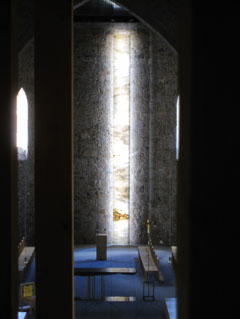
The space of the big chapel in the Minor Seminary is oriented towards the light coming from the far end, which acts as a counter-field of the Cross on the altar aisles.
Looking closer – the eye does not immediately capture these very important « details » – this light comes to us twofold: at first, it is the light of day arising from a vertical wide crevice opened in the wall, but it only illuminates the beyond the altar laterally, as a large installation just cuts in. One is then obliged to come closer in order to better grasp a large marble plate, ribbed of impurities that mark the stone with the brands left by the numerous compressions which enabled her to come into being. This plate is elegantly suspended above the ground, and it is fine enough for the marble to appear bright, not opaque or translucent, but as lit from the inside, although the stone (whose verti-cal hooking tends to erase the weight, thematizing her like a curtain connected to the heights by as-cent, rather than a load secured to the ground by the force of gravity) appears as a radiating, not diffusing, source of light as would be the case with stained glass (which puts forward the external light therethrough). Like a musical instrument radiates its sound (the same being said of a speaker who cannot project her voice but in one limited direction), the stone diffuses light as does a radiant body regarding its internal energy.
Behind the ordinary cross that the plate gracefully enshrines, this peace of marble clearly symbolizes the light of Easter and, generically, the resurrection body of Christ, this luminous and glorious body, which is the true destination of the human body, the exceedingly human body of Jesus suffering on the Cross – in this sense, I hope that a modern cross, less realistic than the classic one currently used, might aesthetically complement this orientation, seeing that the representation of the Cross, after the Resurrection, must not nail down the martyred body of Jesus to his instrument of torture over again (and thus manage the guilt of the faithful for whom Easter is, precisely, the liberation from all suffe-ring) ; accordingly, I anticipate a modern cross expressing the Golgotha as a way point (and not as a station nor as a stop point), as giving access to what really matters : the Eastern Resurrection and the affirmation of this glorious Body, that brought forward a new paradigm authorizing that the Church born at Pentcost, not Christmas, could be called the « Body of Christ ».
The invention of such church is liable to this radiant body : even if we know that the light comes from the back, the outside, from the day the opening in the wall came to being, our feelings imply a different logic, quite distant from « positive » knowledge : the endogenous dynamics of a source diffusing light around, in all directions, not limited to the narrow light beam that ordinary and func-tional light sources can protract.
Our feelings are such that we foresee that here the faithful cannot deal with a specific object (whose own functionality defines her attributes, as can a lamp, a projector, stained glass, an opening) but rather with a specific « thing » with inherent properties : in a place where the object solely demands the understanding of its operating reason, the « thing» demands the understanding of its instrinsic power and the discovery of the non-functional meaning it carries. And just as Christ was not im-mediately identified by those who nevertheless knew Jesus well but only recognized by his gestures (Emmaus) or his words (Mary-Magdalene…), all the same what this stone veil is producing here does not immediately stem from an easily noticeable and distinguishable feature but comes from a sustained and extended gaze capable of printing in the marble a liturgical meaning.
2 – A woman of the people
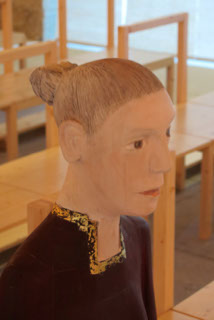
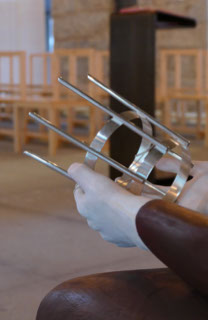
A statue of a woman, at normal scale, sitting quietly and carrying before her a crown, as if ready to pass it on to another, is installed at the front row of seats arranged in the nave.
A plain woman, unadorned, with a robust and dignified bearing: she has just finished her handwork for the day and sits there waiting for the celebration.
We sit beside her, she is our sister in faith. She is not facing us. Our gaze does not grasp her. She is not overlooking. She is not installed in a throne. She is sitting beside each one of us. It is just that she was the first to have taken place in the assembly of the faithful. Her gaze is turned like our own to the beyond the altar and this bright stone irradiating the horizon. The crown she is holding is not for her, as she is handing it towards Whoever will come to take it. She thus shares with the faithful the direction that passes through the Cross and reaches the glorious Body symbolized by the marble ta-pestry, this foyer enveloping the church and profiling the Church as the resurrected Body of Christ.
Mary (here more than Mary-Magdalene), the average woman (the woman of the people rather than the aristocrat), fortunately without the renowned wavy hair celebrated by the Saint-Sulpicians, a woman with no adornment other than her presence and attention to the surroundings and to what may come her way, a woman not yielding to remain at the center of the collective momentum that passes through that space heading to its Eastern destination.
3 – An altar with two sides
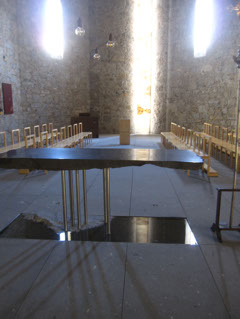
A large black stone sets up the altar. This horizontal granite, perpendicular to the verticality of the marble of light from which it is detached, thus sketches the cross by which we have open access to Easter.
The wide rectangle of the altar is smooth and shiny in its upper side but the side facing the ground is rough, uneven, apparently not carved, as if the stone kept track of her extraction from the rock, as if her irregular thickness bore witness to a mighty pullout from the gangue stone and it reminded us that her regular face had been obtained by the labor of the hand polishing the rock.
The granite surface, whose horizontality is emphasized by the seven thin pillards in shiny steel that support her, is lined on the floor with a thin running water basin leaving room in one of its sides to a strip of land wondrously introduced as gently sloping – the representation of the Jordan and of the gentle slope where one can bathe is self-evident here : the baptism, one finds out, is supporting the horizontal, dark stone of the celebration and making her cross the vertical stone of light.
Again, the symbolism is firm and precise : these motions affect our sensitivity (gazes, displacements, seats…) and guide our thoughts beyond the simple, physical dispositions.
4 – An oriented space, a circular space
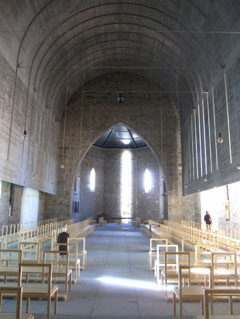
All seats are classically arranged: transversely, towards the altar. But from three quarters of the nave onwards, they are placed on the sides as to draw a sort of choir before the altar, like former clerics’ stalls. Hence the altar is perceived as part of the assembly, not as an extroverted and centri-fugal « avant-garde » external border, but as a completion of a Community circle coming into being at this shade of light produced by the paschal stone.
One should draw the different lines of force that structure the ecclesial space in order to measure the energy composition that comes forth entangled: circles and lines, horizontalities and verticali-ties, centripetal and centrifugal orientations, overlays and intersections…
The church building is both the created casing and the creative agent of the congregation : it hosts while exerting its own pressure-compression dynamics on the assembly; being a container, the content is what imposes its form to the faithful that collectively congregate there.
5 – A liminal filter
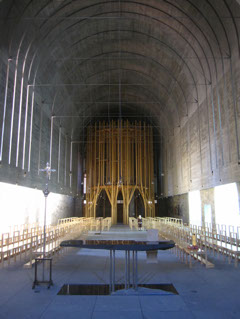
A preliminary trial presides to the introduction in such space. This trial filters the public by a conti-nued dripping : a forest of fine woden pillars is, in fact, the entrance to the chapel so that accessing the nave can only be accomplished by a winding path through them.
The assembly as such cannot be formed but in the nave : it is not simply the transfer, into the church, of the group of outsiders previously gathered on the square; it is an ad hoc composition, a gathering that is part of the celebration : the collective body of the faithful is not a heap of bodies that makes up the human groups waiting to enter the church; it is a body constituted by the celebration itself and hereby intended to be transfigured into the ecclesial Body of Christ.
As such, a procession previously formed outside cannot majestically enter the building, as if an insti-tution outside the space of the celebration could provide the backbone prior to the glorious Body rendered only by the paschal celebration - Easter is not a complementation, a terminal addition to a long history culminating in a perfect construction, like the icing on a cake : Easter is rather a breach, a radical conversion, an opening to a new era, hope in a radically changed present time and not the expectation of a better future, and a finally clear horizon.
To symbolize this conversion as the major issue of the celebration motivating the gathering of the faithful calls for an individual entry, churned out by the antiphon of a forest one has to tread by tracing a path, drawing a route in order to access the place where the ecclesial assembly is gathered : therefore, no transfer, no transitivity between outside and inside, profane and faithful, but a vesti-bule, an intermediate place of conversion.
6 – A riddle
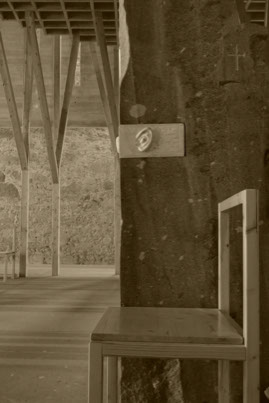
Something extraordinary at the heart of this forest : an ear glued to the single stone pillar whose whole weight comes from this assemblage of wood.
A riddle, it seems to me : is this the stone listening to us and inviting us to come closer and present our intents ? Or is it the symbol of our ear, that we have to use in order to attentively listen to the voices of the place ? In short, to whom does this ear give access to? And to what voices?
Clearly, the ear points out to another use of its place : not the filtering space between outside and inside, grouped and gathered, but the moment, out of the celebration, to meditate and no doubt to confess…
7 – A contrast between two chapels
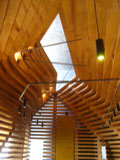
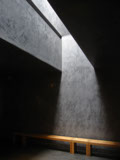
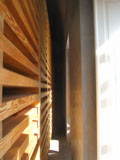
The big chapel of the Minor Seminary (the one just discussed) contrasts with the small chapel (Tree of Life) of the Major Seminary.
- Two destinations : on one side a vast assembly oriented for the celebration of Easter; on the other a small group centered on collective meditation.
- Two spatial forms : on one side a large arrow; on the other a small ellipse.
- Two dynamics : on one side the overlay of different plans, on the other, an upward spiral.
- Two entrances : on one side a forest engaging the public serially into faithful believers; on the other a « purgatory » where the soul is converted by crossing the chiaroscuro of a vestibule.
- Two casings: on one side a vast nave, narrowed by another one, suspended and attached to the first one in order to better support her flying-buttresses; on the other a small wooden shell, light in color, Noah’s ark sitting inside a large paralleliped in dark stone.
The contrast is clear but in both cases it revolves around the same aesthetic orientation, one that defi-nitely relies on the refinement of bereavement.
Text: François NICOLAS
Tr.: Joana Jacinto
Pictures: Guillaume Nicolas, Lisa Sigfridsson, Joaquim Félix
***
Born in 1947, from a young age François Nicolas learnt the piano and then the organ (Albert Alain). After some scientific studies (École Polytechnique), he performed jazz for a while before turning to contemporary music. In completing his musical studies - piano with Carlos Roqué-Alsina, composition Michel Philippot - he met Mauricio Kagel and Luciano Berio (Acanthes, 1981 and 1983), Brian Ferneyhough (Darmstadt, 1982 and 1984) and took the computer music course for composers at Ircam.
As an assistant at the Conservatoire de Paris, he cofounded the journal Entretemps (1986) and joined the editorial committee of the Revue de musicologie (1988) while appearing regularly as a guest producer on France-Musique.
During the ‘90s, François Nicolas worked at Ircam as a researcher and composer (implementing the Modalys software - synthesis through physical models - then the Timée - a multi-loudspeaker source). There he organised the Samedis d’Entretemps (meetings around books on music) and various seminars (Entretemps).
Since 2003, he has worked at the École Normale Supérieure (rue d’Ulm, Paris) as an associate professor and researcher. There he organises diverse meetings under the auspices of mamuphi (seminars dedicated to the exploration of mathematics, music, and philosophy).
Nicolas’ musical works are published by Jobert. They have been performed by various ensembles (Ensemble Intercontemporain, l’Itinéraire…) and by numerous performers (J.-L. Étienne, R. Garioud, M. Jordan, M. Kobayashi, H. Larbi, A. Minck, N. Miribel, A. Neveux, P. Rophé, F. Tanada, J. Wood…). He is currently composing a tetralogy (symphony, cantata, madrigal and opera) called Égalité ’68, which celebrates (in French, German, Russian and Arabic) the fiftieth anniversary of May 1968.
Nicolas combines composition with theoretical reflection. After many books (on Schoenberg, the concert, Boulez…) and numerous articles, he will next publish a vast work The World-Music and its listening in the Work.